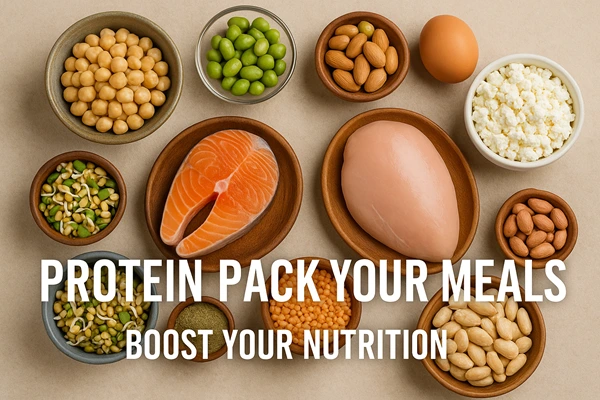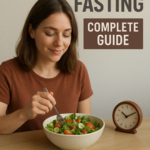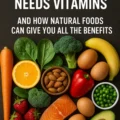The Silent Nutrition Crisis in Indian Homes
In the land of spices, vibrant curries, and age old culinary traditions, there’s one crucial nutrient that often slips through the cracks of our plates protein. While our meals are rich in taste, culture, and variety, they often fall short in providing enough of this essential macronutrient.
It’s ironic, isn’t it? A country like India, home to diverse food traditions and centuries of Ayurvedic wisdom, now faces a growing concern: protein deficiency. Whether you’re a busy professional skipping breakfast, a vegetarian relying mostly on carbs, or a fitness enthusiast gulping down protein shakes — the truth is, most Indians are not getting enough protein from their everyday meals.
According to the Indian Market Research Bureau, nearly 80% of Indian diets are protein deficient, with the problem being more severe among women, vegetarians, and children. And what makes it even more alarming is that most people aren’t even aware of it. Fatigue, hair loss, constant hunger, mood swings — we often chalk these up to stress or lifestyle, but protein deficiency could be quietly at play.
So why is protein such a big deal? And how did such a fundamental nutrient become so rare on our plates?
Why Indians Are Suddenly Talking About Protein Deficiency
1. Rising Awareness Around Fitness and Health
Gone are the days when only athletes talked about protein. With increasing awareness about lifestyle diseases like obesity, diabetes, and PCOS, people have begun to understand the role of protein in overall health. It’s not just about muscle gain — protein supports metabolism, hormonal balance, immunity, and even weight loss.
2. Social Media and the “Gym Lifestyle”
Instagram reels and YouTube fitness influencers have made “high-protein diets” the new norm. Their morning smoothies, grilled chicken bowls, and whey protein shakes have glorified protein as the magic nutrient. The message is clear: “Want to look good? Get more protein.”
3. Urban Lifestyles = Low Nutrition Intake
With the rise of fast food, skipped breakfasts, and late-night Maggi dinners, most Indians (especially urban youth) are eating carb-heavy but nutrient-poor meals. Protein deficiency has quietly crept into millions of diets — without them even knowing.
Signs You May Be Protein Deficient (And Don’t Even Know It)
- Constant fatigue and low energy
- Weak nails, hair fall
- Poor recovery after workouts
- Frequent hunger pangs
- Low immunity (frequent colds/cough)
If you’ve been noticing any of these symptoms, it’s worth examining your protein intake.
How Much Protein Do Indians Actually Need?
According to the Indian Council of Medical Research (ICMR), the recommended daily protein intake is:
- 1 gram per kg of body weight
So, a person weighing 60 kg needs approximately 60 grams of protein/day.
But here’s the kicker:
A recent study by the Indian Market Research Bureau found that close to 80% of Indian diets are protein deficient, especially among vegetarians and women.

Common Indian Meals Are Often Low in Protein
Let’s look at a regular vegetarian Indian thali:
- 2 chapatis
- A bowl of dal
- Some sabzi
- Rice
- Curd
While nutritious, this meal hardly gives 15–18 grams of protein.
Even non-vegetarian meals like chicken curry with rice can fall short if not portioned right.
The Protein Powder Boom — And the Risks Involved
With the realization that their meals are lacking, many Indians have turned to protein powders and supplements. Walk into any gym or sports store and you’ll see shelves stacked with whey protein, plant protein, isolate blends, BCAAs, and more.
But is that really necessary?
The Risks of Overusing Protein Powders:
- Kidney Strain – Excess protein, especially from supplements, can stress kidneys over time.
- Digestive Issues – Bloating, gas, or diarrhea are common complaints, especially with low-quality powders.
- Artificial Additives – Many powders contain preservatives, synthetic flavors, and sweeteners.
- Imbalance – Relying too much on powders can lead to neglecting other essential nutrients like fiber, vitamins, and good fats.
Expert tip: Protein powders are best used as a supplement, not a primary source. They’re useful for athletes, bodybuilders, or people with higher protein needs but not mandatory for the average Indian.
How to Easily Get the Right Protein from Your Indian Kitchen
Yes, you can absolutely meet your daily protein goals through your regular Indian meals — no imported food or fancy diet required.
Let’s break it down by Vegetarian and Non-Vegetarian options.
Vegetarian Protein Sources (Desi & Powerful)
| Food Item | Protein (per 100g) | How to Include |
|---|---|---|
| Moong Dal | 24g | Add to khichdi, dal soups |
| Masoor Dal | 25g | Use in dals, dosa batters |
| Chana (Black Gram) | 20g | Sprouted chana salads, curries |
| Soya Chunks | 52g | Curry, pulao, tikka |
| Paneer | 18g | Add to sabzi, grill it, bhurji |
| Greek Yogurt (Hung Curd) | 10g | Snack or raita |
| Peanuts | 25g | Chutney, snacks, laddoos |
| Almonds | 21g | Soak overnight or blend into smoothies |
| Besan (Gram Flour) | 22g | Chilla, pakoda, paratha filling |
| Tofu | 10–12g | Great plant-based protein substitute |
| Milk (1 glass) | 6.5g | Drink, or use in porridge |
Pro Tip: Combine cereals and pulses (like rice and dal, or chapati and rajma) to get a complete amino acid profile.
Non-Vegetarian Protein Sources
| Food Item | Protein (per 100g) | How to Include |
|---|---|---|
| Chicken Breast | 31g | Grilled, stir-fried, curry |
| Eggs (1 large) | 6g | Boiled, omelette, egg curry |
| Fish (Rohu, Salmon, etc.) | 20–25g | Curry, grilled, fry |
| Mutton (lean) | 25g | Once/twice a week, not daily |
| Prawns | 24g | Stir-fry, masala curry |
Boiled eggs, grilled chicken, and fish curry can easily boost your protein levels without needing any supplement.
Sample Daily Indian Meal Plan (Veg and Non-Veg)
Vegetarian Plan (60–70g Protein)
- Morning: Soaked almonds (6), 1 glass milk
- Breakfast: Besan chilla with curd
- Lunch: 2 chapatis, dal tadka, palak sabzi, salad
- Evening: Roasted chana or peanut chaat
- Dinner: Soya pulao with cucumber raita
- Before bed: Warm turmeric milk
Non-Vegetarian Plan (70–80g Protein)
- Morning: Boiled egg (2), 1 glass milk
- Breakfast: Egg bhurji + toast
- Lunch: Chicken curry, chapati, rice, salad
- Evening: Greek yogurt + fruits
- Dinner: Fish curry with rice or roti
- Before bed: Handful of almonds or warm milk
FAQs: Answering Common Protein Deficient Questions
Q. Is Too Much Protein Dangerous?
Yes, anything in excess is harmful. Over 2g/kg of body weight consistently can strain kidneys and lead to dehydration, especially if your water intake is low.
Q. Can Children and Elderly Have High-Protein Foods?
Absolutely. In fact, growing children and seniors often don’t get enough protein. Just keep it from natural sources like milk, eggs, dal, and paneer.
Q. Are Protein Powders Safe?
Yes, if they’re from trusted brands, taken in moderation, and not replacing regular meals. Avoid powders with artificial colors, flavors, or added sugars.
Q. What About Weight Loss?
Protein helps you feel fuller longer, supports muscle retention, and boosts metabolism — making it crucial for healthy fat loss
Final Thoughts: Rethink Your Plate, Not Your Pocket
The protein obsession in India isn’t entirely misplaced. As we shift towards more sedentary lifestyles, ensuring our body gets the right fuel becomes essential.
But instead of chasing imported supplements or blindly copying influencer diets, let’s go back to our rich Indian culinary roots. From dals to dairy, eggs to fish, our kitchens already have the power to nourish us — we just need to be a little more mindful.
For more Health and Lifestyle Updates, Follow Popnewsblend.com.

Hi, I’m Prashant Jain — a curious soul, storyteller, and content creator at heart.I’ve always been drawn to the world of entertainment, travel, sports, health & lifestyle — not just as a writer, but as someone who genuinely lives these experiences. Whether I’m binge-watching the latest OTT series, exploring offbeat spiritual destinations in India, or diving deep into wellness routines and cricket match insights, I love sharing what I discover with like-minded readers.
PopNewsBlend is my way of blending personal journeys with meaningful stories — ones that inform, inspire, and keep you ahead of the curve. Everything I write comes from real observations, hands-on experiences, and a deep passion for understanding the world around us.
Discover more from Popnewsblend
Subscribe to get the latest posts sent to your email.







